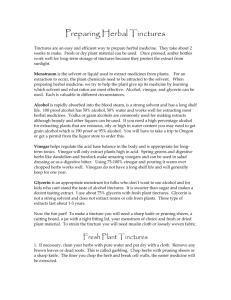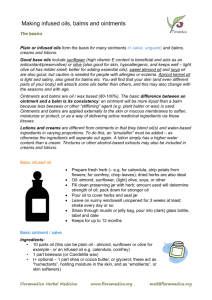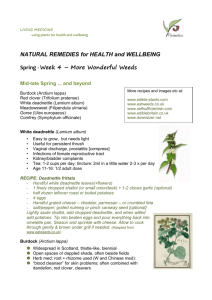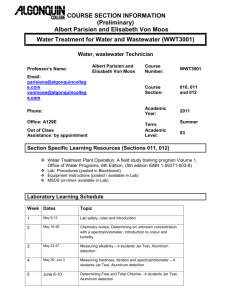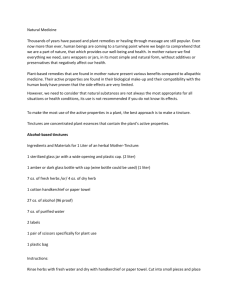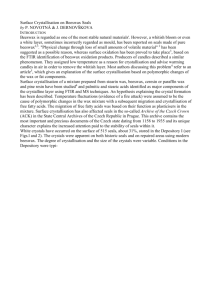Instructions for Pharmacy Herbal Lab Oct
advertisement
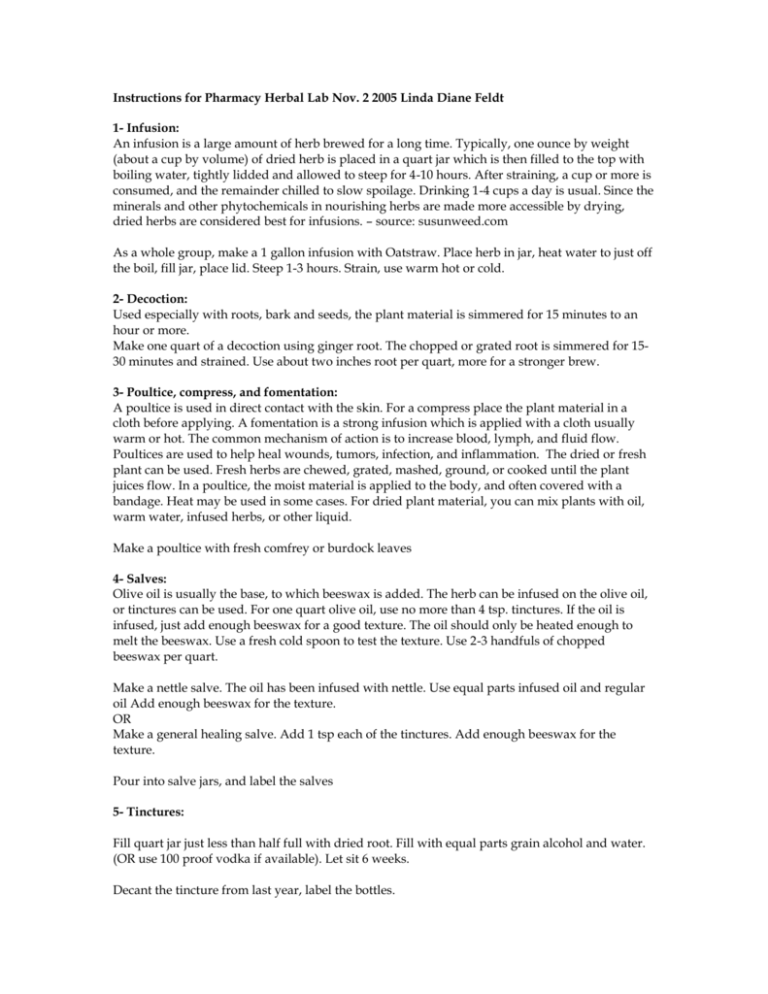
Instructions for Pharmacy Herbal Lab Nov. 2 2005 Linda Diane Feldt 1- Infusion: An infusion is a large amount of herb brewed for a long time. Typically, one ounce by weight (about a cup by volume) of dried herb is placed in a quart jar which is then filled to the top with boiling water, tightly lidded and allowed to steep for 4-10 hours. After straining, a cup or more is consumed, and the remainder chilled to slow spoilage. Drinking 1-4 cups a day is usual. Since the minerals and other phytochemicals in nourishing herbs are made more accessible by drying, dried herbs are considered best for infusions. – source: susunweed.com As a whole group, make a 1 gallon infusion with Oatstraw. Place herb in jar, heat water to just off the boil, fill jar, place lid. Steep 1-3 hours. Strain, use warm hot or cold. 2- Decoction: Used especially with roots, bark and seeds, the plant material is simmered for 15 minutes to an hour or more. Make one quart of a decoction using ginger root. The chopped or grated root is simmered for 1530 minutes and strained. Use about two inches root per quart, more for a stronger brew. 3- Poultice, compress, and fomentation: A poultice is used in direct contact with the skin. For a compress place the plant material in a cloth before applying. A fomentation is a strong infusion which is applied with a cloth usually warm or hot. The common mechanism of action is to increase blood, lymph, and fluid flow. Poultices are used to help heal wounds, tumors, infection, and inflammation. The dried or fresh plant can be used. Fresh herbs are chewed, grated, mashed, ground, or cooked until the plant juices flow. In a poultice, the moist material is applied to the body, and often covered with a bandage. Heat may be used in some cases. For dried plant material, you can mix plants with oil, warm water, infused herbs, or other liquid. Make a poultice with fresh comfrey or burdock leaves 4- Salves: Olive oil is usually the base, to which beeswax is added. The herb can be infused on the olive oil, or tinctures can be used. For one quart olive oil, use no more than 4 tsp. tinctures. If the oil is infused, just add enough beeswax for a good texture. The oil should only be heated enough to melt the beeswax. Use a fresh cold spoon to test the texture. Use 2-3 handfuls of chopped beeswax per quart. Make a nettle salve. The oil has been infused with nettle. Use equal parts infused oil and regular oil Add enough beeswax for the texture. OR Make a general healing salve. Add 1 tsp each of the tinctures. Add enough beeswax for the texture. Pour into salve jars, and label the salves 5- Tinctures: Fill quart jar just less than half full with dried root. Fill with equal parts grain alcohol and water. (OR use 100 proof vodka if available). Let sit 6 weeks. Decant the tincture from last year, label the bottles. 6- Herbal Oils: Clean and chop the yellow dock root or catnip leaf. Use enough root to fill the jar about 1/3 to 1/2 full. If you are using leaf, lightly fill close to the top. Fill to top with olive oil, shake so air bubles rise to the top, and top off with olive oil. Label the jar.

